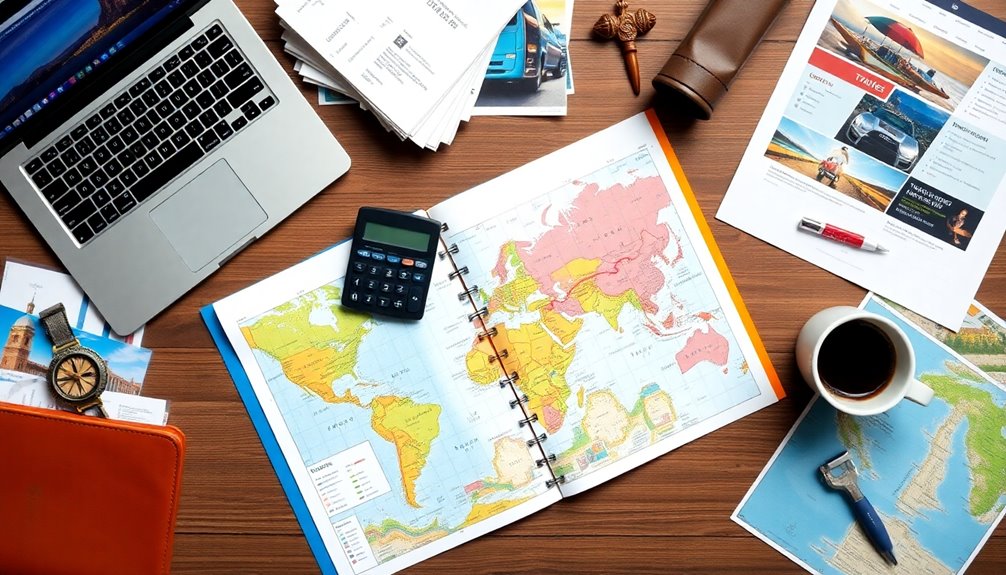To plan your road trip, start by setting a realistic budget that includes fuel, accommodations, food, and unexpected expenses. Research and book your accommodations through websites like Booking. com or Airbnb, and don’t forget to check reviews and cancellation policies. Map out your route, highlighting scenic spots and key destinations. Prepare your vehicle, pack essentials, and stay adaptable to changes along the way. Want to explore more tips for a smooth journey? There’s plenty more to discover! Additionally, consider creating a checklist of road trip planning essentials, such as snacks, entertainment options, and emergency supplies. Keeping a first-aid kit handy is also a smart precaution for any unexpected situations. Lastly, engage with fellow travelers online or through social media to gain insights and recommendations that can enhance your journey.
Key Takeaways
- Establish a realistic budget by evaluating savings, estimating fuel costs, and allocating funds for accommodations, food, and unexpected expenses.
- Research and compare accommodation options using platforms like Booking.com and Airbnb, considering cancellation policies and reviews for safety.
- Plan your route by identifying key destinations, mapping scenic routes, and allowing flexibility for spontaneous detours and local events.
- Ensure your vehicle is well-maintained and create a detailed packing list, including snacks and emergency supplies, before hitting the road.
- Use budgeting apps to track expenses on the go, maintain open communication with travel companions, and embrace adaptability during the trip.
Establishing Your Road Trip Budget

When planning a road trip, it's crucial to establish a budget that aligns with your financial situation, so you can enjoy the journey without money worries.
Start by evaluating your current savings and income to set a realistic budget limit for expenses. Calculate your estimated fuel costs by mapping out your route and factoring in your vehicle's fuel efficiency and current gas prices.
Research accommodation options like hotels, campgrounds, or vacation rentals, comparing prices to guarantee you stay within your budget while maintaining comfort.
Don't forget to plan your food budget, deciding on a mix of dining out and preparing meals.
Finally, allocate funds for miscellaneous costs, including tolls and parking fees, to guarantee a smooth travel experience.
Researching and Booking Accommodations

After setting your road trip budget, it's time to focus on finding suitable accommodations that fit your plans.
Start by researching options on platforms like Booking.com or Airbnb, where you can compare prices, amenities, and user reviews. Always check cancellation policies and read reviews to guarantee the place meets your expectations and is in a safe area.
If you're traveling with an RV, use campground review sites like Campendium and RV Life for detailed information.
Booking accommodations in advance is essential, especially during peak seasons, to secure the best deals and avoid last-minute issues.
Don't forget to take into account alternative lodging like hostels or vacation rentals, which can save money and give you a local experience.
Planning Your Route and Stops
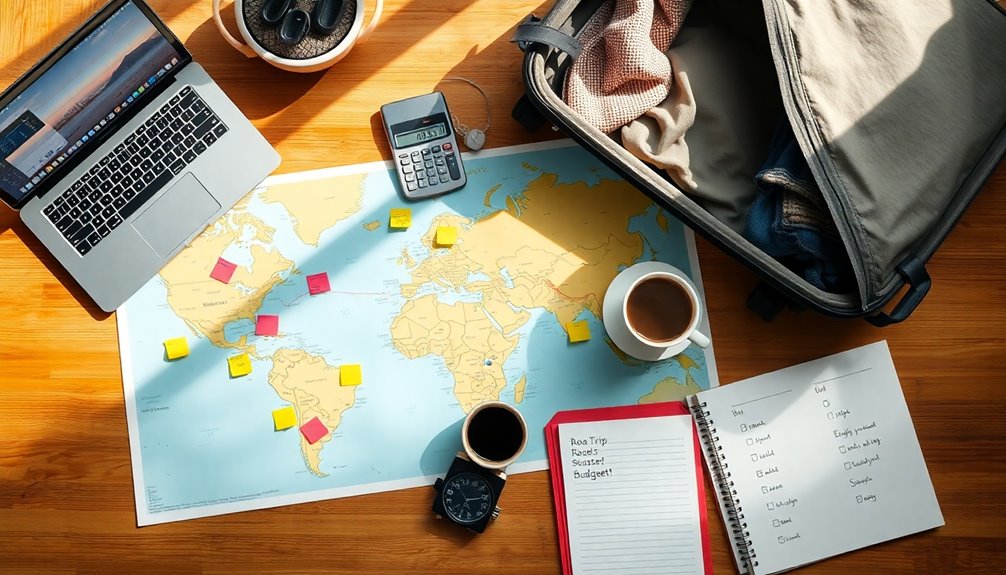
When planning your route, start by identifying key destinations that you don't want to miss.
Map out scenic routes to enjoy the journey, and include attractions along the way to break up the drive.
This approach not only makes the trip more enjoyable but also creates lasting memories.
Identify Key Destinations
How do you choose the right stops for your road trip? Start by selecting a few major key destinations that excite you. Aim for a mix of new experiences and familiar favorites to enrich your journey.
Utilize resources like Pinterest and travel communities to gather inspiration, especially for spots west of the Mississippi River. The RoadTrippers app can help you visualize your route, identifying attractions and estimating travel costs.
Prioritize national parks and unique attractions in your itinerary, and be sure to research any reservation requirements. To maintain a manageable travel pace, allocate three days per destination. This way, you can fully experience each location without feeling rushed while planning your road trip. Additionally, consider including camping locations to enhance your adventure with outdoor experiences.
Map Scenic Routes
Mapping scenic routes can transform your road trip into an unforgettable adventure. Using Google Maps, search for "scenic byways" or "backroads" to discover breathtaking landscapes. The Roadtrippers app can customize your journey, recommending quirky attractions and local eateries. Don't forget to include national and state parks for stunning views, hiking trails, and recreational options. Many families also enjoy planning stops at hotels with water parks to enhance their travel experience.
Here's a quick table to help you plan:
| Type of Route | Example |
|---|---|
| Well-Known Scenic | Pacific Coast Highway |
| Lesser-Known Backroad | Blue Ridge Parkway |
| National Park | Yellowstone National Park |
| State Park | Red Rock Canyon State Park |
| Cultural Landmark | Route 66 |
Incorporate these elements into your road trip planning for a journey filled with memories.
Include Attractions Alongway
Including attractions along your route can elevate your road trip from a simple drive to a memorable journey filled with discovery. Use planning apps like Roadtrippers to uncover unique stops, from state parks to quirky roadside landmarks.
Research local attractions to create a diverse itinerary that caters to different interests. Make sure to incorporate time for spontaneous detours; some of the best experiences come from unexpected adventures.
Check for seasonal events or festivals along the way, as they offer a taste of local culture. For example, consider including a visit to water parks that provide family-friendly attractions and fun activities for all ages. By mixing popular tourist destinations with lesser-known hidden gems, you'll avoid crowds and enhance your trip with unforgettable moments.
Embrace the journey, and let each stop become a part of your road trip story.
Preparing for the Journey
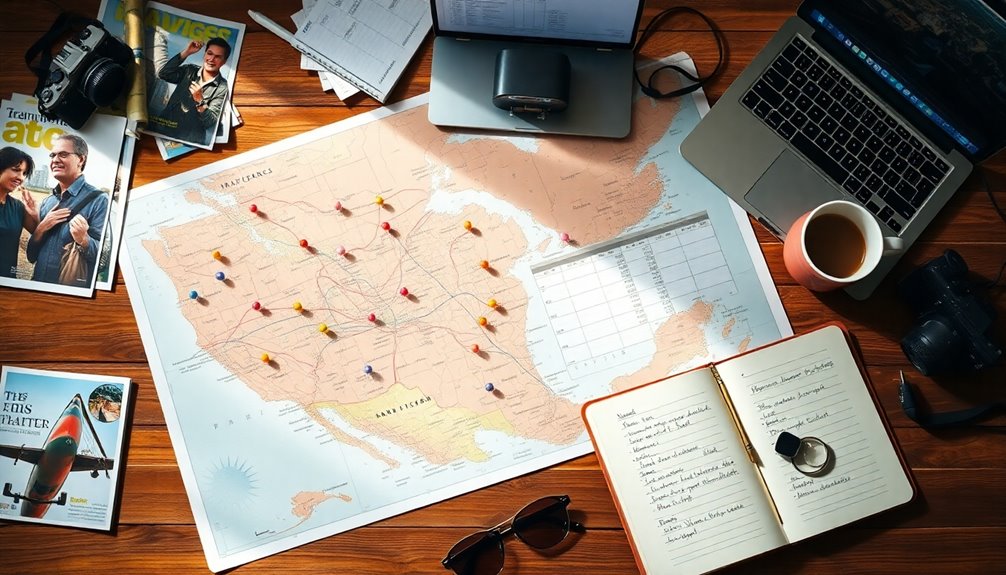
Before hitting the road, it's crucial to guarantee your vehicle is in top shape. Check your maintenance needs like oil changes, tire pressure, and fluid levels. This assures you're road-ready.
While preparing for the journey, you'll also want to create a detailed packing list to avoid forgetting essential items.
Consider including:
- Snacks and water
- A first aid kit
- Emergency supplies
- Comfortable clothing
- Chargers for devices
Additionally, research and book accommodations in advance to secure the best rates. Use apps like GasBuddy to find the cheapest fuel prices along your route. It's also important to pack healthy snacks for pets if you're traveling with animals to ensure their well-being during the trip.
Establish a communication plan with your travel companions to keep everyone informed about the itinerary and any changes during your trip.
Happy travels!
Packing Essentials for Your Road Trip
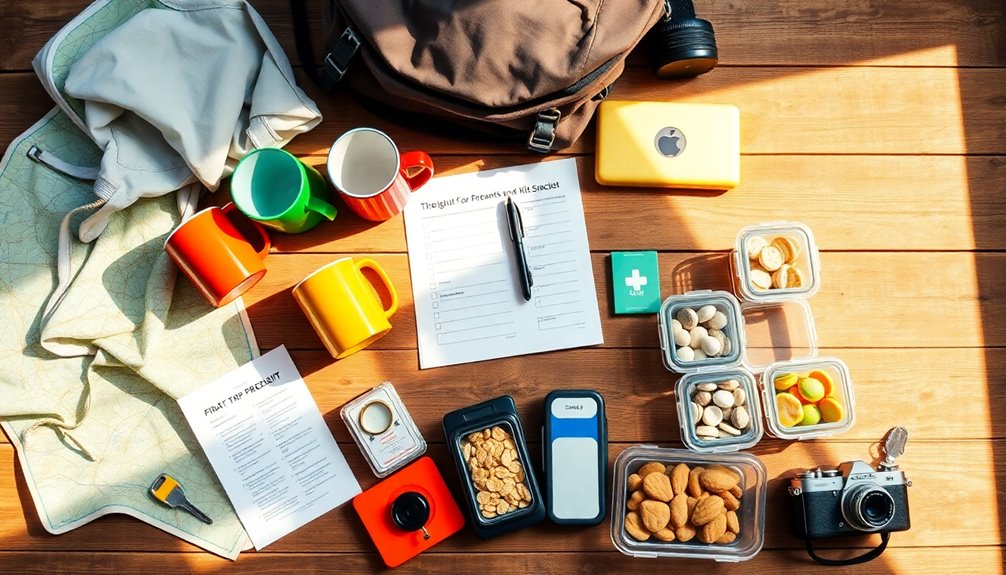
Packing for a road trip can feel overwhelming, but with a solid plan, you can guarantee you have everything you need for a smooth journey. Start by making a thorough list of packing essentials like clothing suited for your destination's weather and toiletries. Don't forget a first aid kit with band-aids, antiseptic wipes, and pain relievers for any minor injuries. Include emergency items like a flashlight and jumper cables. Snacks and drinks in a cooler will save you from unnecessary stops, while portable phone chargers keep your devices powered. Here's a quick packing checklist:
| Essentials | Emergency Items | Entertainment |
|---|---|---|
| Clothing | Flashlight | Music playlists |
| Toiletries | Jumper cables | Audiobooks |
| First aid kit | Blanket | |
| Snacks & drinks |
Managing Your Budget on the Road
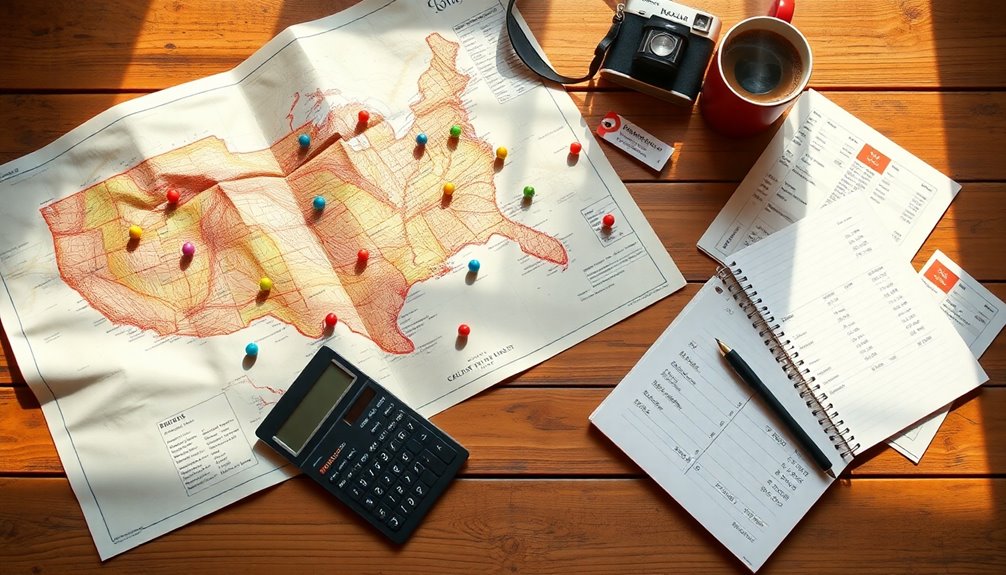
Managing your budget on the road is essential for a stress-free trip, especially when unexpected expenses can pop up at any moment.
Here are some tips to help you stay on track:
- Estimate gas costs by mapping your route and checking fuel efficiency.
- Allocate a daily food budget, balancing dining out and cooking.
- Track miscellaneous expenses like tolls and parking fees in a separate category.
- Set aside an emergency fund for unexpected costs, like repairs or last-minute lodging.
- Use budgeting apps like Trail Wallet to monitor your spending in real-time.
Additionally, consider creating a personal budget before your trip to account for all expected expenses.
Adapting to Changes and Unexpected Events
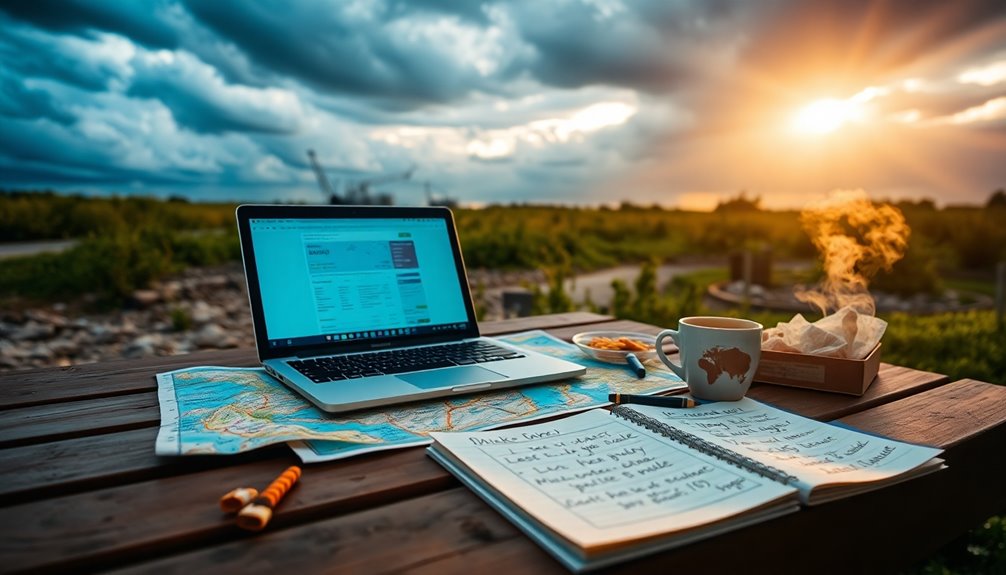
While you can plan every detail of your road trip, it's crucial to remain adaptable when changes and unexpected events arise.
Keep an emergency fund of 10-15% of your total budget to cover unexpected expenses like vehicle repairs or medical emergencies. Consider getting travel insurance that protects against trip cancellations or interruptions to prevent financial losses.
A flexible itinerary is crucial; allow for buffer days and alternative routes to navigate weather changes or road closures smoothly. Regularly communicate with your travel companions about any adjustments to guarantee everyone stays informed.
Finally, download offline maps and travel apps to stay connected and navigate effectively, even in areas with poor cell service. Adaptability is key to enjoying your adventure! Additionally, open communication can help you address any worries or concerns that may arise during your travels.
Frequently Asked Questions
How to Plan a Trip Step by Step?
To plan a trip step by step, start by choosing your destination and figuring out how long you want to stay.
Next, set a budget that covers transportation, lodging, food, and activities.
Research must-see attractions and optional stops to create a balanced itinerary.
Use mapping tools to plot your route, guaranteeing driving times are reasonable.
Finally, book accommodations and make a packing list to guarantee you're ready for a smooth adventure.
How Much Money Should You Budget for a Road Trip?
You should budget around 40% of your total funds for transportation costs, like fuel, which you can calculate based on your trip's distance and your vehicle's MPG.
Set aside 30% for accommodations, aiming for about $100-$150 per night.
Allocate 20% for food, allowing $30-$60 per person daily.
Finally, reserve 10-15% for unexpected expenses.
This way, you'll be prepared for both planned costs and any surprises along the way.
How Far in Advance Should I Plan a Road Trip?
Planning a perfect road trip? You'll want to start at least three to six weeks ahead. This gives you time to research routes, reserve accommodations, and refine your itinerary.
If you're heading on a longer journey, consider extending that timeline to several months, especially for popular spots. Early booking not only secures your stay but also saves you money.
Don't forget to check your car's condition about a week before you hit the road!
How to Calculate Costs for a Road Trip?
To calculate costs for your road trip, start by determining your total driving distance and your vehicle's fuel efficiency.
Use current fuel prices to estimate fuel costs. Next, research accommodation rates for your stops and multiply by the number of nights.
Budget for daily food expenses and consider packing snacks.
Don't forget to include costs for activities and miscellaneous expenses like tolls and parking.
Having a clear budget helps guarantee a smoother trip!
Conclusion
As you hit the open road, remember that each mile is a brushstroke on the canvas of your adventure. You've mapped out your budget, booked cozy spots, and packed your essentials—now it's time to let spontaneity be your co-pilot. Embrace the detours and unexpected twists; they're the spice in your journey. So buckle up, crank the tunes, and let the wind guide you. Your unforgettable road trip awaits, ready to paint memories that'll last a lifetime!
